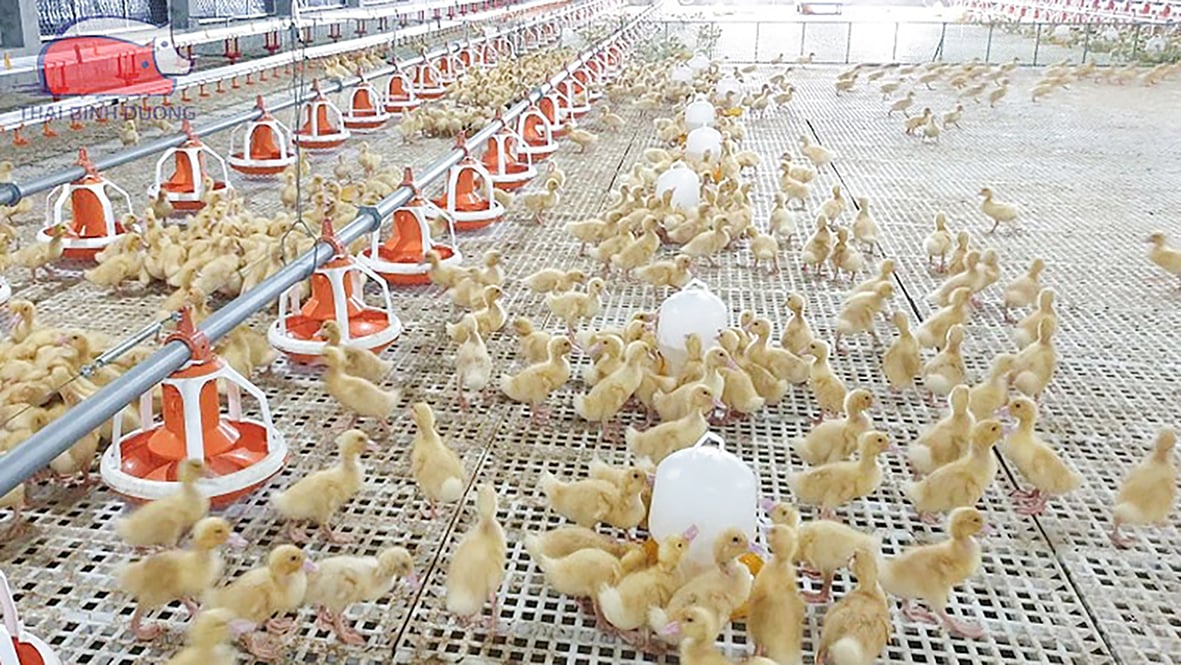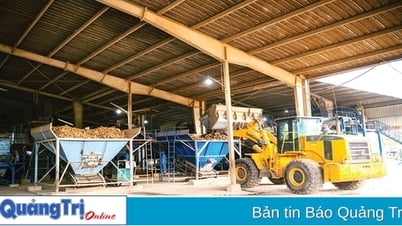The model of raising ducks on the floor is being piloted by the Agricultural Extension Center - Photo: TTKN
Raising ducks on the floor has the advantage of creating a well-ventilated, dry, clean environment, minimizing the risk of infection caused by bacteria, mold and parasites because the animals do not come into direct contact with wet soil and their waste, thereby helping the duck flock grow quickly, egg and meat production increases significantly, and product quality is improved.
Floor duck coops must be built scientifically and reasonably to ensure health and high productivity. Choose high, airy places to build duck coops, away from polluted water sources and crowded areas. The coop must be large enough and have a reasonable structure so that the ducks have a comfortable living space.
The cage must be built of cement to facilitate cleaning, waste control and disease prevention. The walls are equipped with a ventilation fan system to control humidity and odors. Provide enough water for the ducks to drink freely and bathe. Ducks under 1 week old should not be given cold water below 15oC.
Regarding stocking density, for ducklings, the stocking density is 7 - 10 ducks/m2, for adult ducks, the appropriate density is 3 - 4 ducks/m2 to create a comfortable space for ducks to live and walk on the floor, reduce competition for living among the ducks, help improve their health and farming efficiency thanks to the ducks growing quickly. The two factors of density and size of the duck flock directly affect the growth ability and have a close relationship with each other.
Ducks grow quickly when raised at moderate density and grow slowly when the breeder releases ducks at a density that exceeds the prescribed level, forcing them to compete for food and living environment. It is necessary to pay attention to the temperature in the duck house to adjust it to suit each age group. For ducks from 1 to 3 days old, maintain the house temperature from 31 to 32oC; for ducks from 4 to 8 days old, maintain the house temperature from 29 to 30oC; for ducks from 9 to 13 days old, maintain the house temperature from 27 to 28oC; for ducks from 14 to 28 days old, maintain the house temperature from 25 to 26oC.
Ducks over 28 days old should be raised in a natural temperature environment. Young ducks must have a lighting regime: 24/24 hours in the first week; 20/24 hours in the second week; 16/24 hours in the third week; from the 4th week onwards, ducks live in natural light conditions.
Farmers must pay attention to managing the environment in the barn well to ensure the health of the ducks and help them gain weight quickly. One of the important factors that need to be controlled is the humidity in the barn at the most suitable level of 60% - 70%.
Humidity that is too high or too low can affect the health of ducks, increasing the risk of respiratory diseases and other health problems. Maintaining humidity at this level helps create an ideal living environment, helping ducks thrive and increase their ability to resist diseases.
Regular cleaning and disinfection of the barn helps eliminate pathogens, bacteria, and parasites that can harm the duck flock. Ensuring a clean environment not only minimizes the risk of disease but also contributes to maintaining the long-term health of the ducks. Measures such as regular cleaning, using appropriate disinfectants, and keeping the barn cool will help control the living environment of the ducks, ensuring a sustainable and effective farming environment.
Feed ducks with industrial feed, using feed provided by reputable livestock and poultry feed companies. Feed for ducks is divided into 2 stages: Stage 1 from 1 - 21 days old, feed ducks with feed that reaches 20% digestible protein, energy 2,890 kcal. Stage 2 from 22 - 56 days old, feed ducks with feed that reaches 16% digestible protein, energy 2,890 kcal. Commercial ducks feed 15% digestible protein, energy 3,000 kcal.
Before feeding the ducks, clean the trough, sweep away leftover, smelly, rotten and moldy food, feed the ducks several times a day to avoid spillage and spoilage, separate the young ducks and feed them separately so that the ducks can develop evenly. For commercial ducks, feed the ducks naturally. Ducks from 7 days old onwards can start to be vaccinated against hepatitis, cholera, and avian influenza. It is necessary to proactively vaccinate the ducks when they are still healthy to ensure disease safety for the ducks.
Commercial ducks 70 days or older can be sold when the vaccines injected into the ducks have passed the decomposition period. Currently, the price of duck meat on the market is quite high, the model of raising ducks on the floor complies with the farming processes to ensure disease safety, so farmers have high economic efficiency. This is a model that needs to be replicated to create a stable source of income for farmers.
Tran Anh Minh
Source: https://baoquangtri.vn/ung-dung-tien-bo-ky-thuat-vao-chan-nuoi-vit-193207.htm






![[Photo] Crane falls on container truck and car at traffic construction site](https://vphoto.vietnam.vn/thumb/1200x675/vietnam/resource/IMAGE/2025/5/31/a8d3ae08da324cfe8ee406174c0eacc4)


























































































Comment (0)